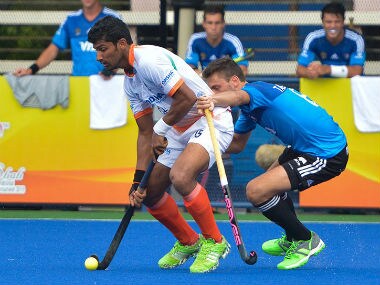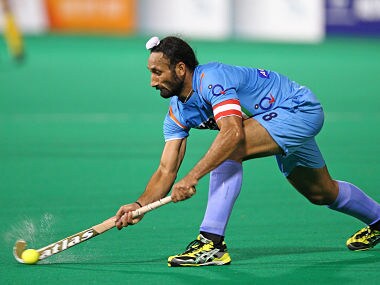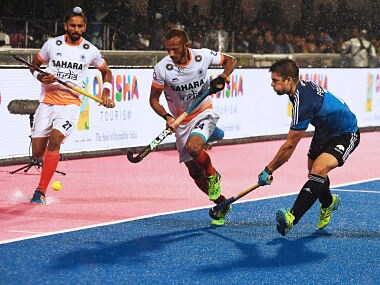With his inventive penalty corner flicking, Argentina’s Gonzalo Peillat not only scored a match-defining hat-trick but stood like a colossus between a point gained and a match lost for India.
The Asian Cup Champions started on a pace that scorched the turf in the first 10 minutes. Sumit Kumar dazzled on the flank, cut through the Argentine defence with ease and it seemed that momentum would hold for India. Then, Surender Kumar also unleashed a defence-splitting pass that found Nilam Xess, but Argentina’s Juan Vivaldi, 38-year-old and 18 years as Argentina’s custodian, held off three one-to-one situations with the Indian forwards.
The storm passed. And Argentina, masters at counters and short passes, led 2-0 before India created chances again to equalise 2-2 — Amit Rohidas causing the destruction in this case. But Peillat hovers like a drone waiting for that one opportunity to showcase his skills. It came in the 33rd minute when Suraj Karkera had replaced Krishan Pathak as India’s goalkeeper in the third quarter. The flick was fast and deep in the corner.

India's S Uthappa in action during the tournament opener against Argentina. Image credit: Twitter/@TheHockeyIndia
Despite a 45-minute break caused by lightning and thunder showers, India couldn’t come back into the match. India would rue the initial missed chances and the amateur manner in which they allowed the South Americans back into the game. The 3-2 score-lined underlined Argentina’s domination but it wouldn’t create too many doubts. They know they can still come back into this tournament.
Indian coach Sjoerd Marijne appreciated the team’s efforts. “I am very proud of the way the boys played,” he said. “One needs to understand that Argentina is the Olympic Champions. And they played like Champions. We had chances but we couldn’t hold the play.” The Dutchman also said that technically India let itself down and there were moments they couldn’t trap cleanly and gave the advantage away to Argentina, leading to counter-attacks.
There was a certain abandon in the game play that India displayed against Argentina. One wonders whether the departure of Carlos Retegui as coach would weigh in on Argentina. But this is a not a team that is the Olympic champion for nothing. Team manager Javier Blanco said after the match that India play fast hockey and they were taken by surprise in the first 10 minutes before the team settled down by killing the pace.
“We know India is an extremely dangerous team and after the initial attacks, we decided to hold the ball and create space in the midfield and attack from the flanks,” explained Javier. The Argentina manager was happy that with a player like Peillat in the team, a victory is always possible as "he is dangerous when it comes to penalty corners."
The surprising factor in the Indian side was the midfield, which didn’t fire. Under Sardar Singh, S Uthappa and the energetic Sumit, it should have held sway, but slowly faded away instead. The unforced errors didn’t help either. Too many loose balls and 32 percent of India’s play went to Argentine sticks, which resulted in counter-attacks. Two of those turned into penalty corners, and Peillat is not the kind who would look down on a gift horse in the mouth.
For a player who scored 10 goals in the 2014 World Cup — all of them through penalty corners — followed by 11 at the 2016 Rio Olympics, he is without a doubt the trump card of this South American team. And they undoubtedly rely on him. Team manager Blanco meant every word when he said, “Peillat is the match-winner of this team.”
But it wasn’t said to undermine the rest. They work towards the goal of creating penalty corners. Pedro Ibarra, Lucas Vila, Diego Paz, Lucas Rossi create space and then with short passes find the feet and legs of the opposition in the striking circle. They found a forest of Indian feet in the striking circle and got seven PCs; three was the least that Peillat would deliver. Even Marijne admitted that when you give seven PCs to Argentina, they are bound “to score two or three.”
Hampered by the lack of mobility in the midfield, the defence was under pressure constantly. And the lack of a structure didn’t help. Xess, Rohidas, Surender and Dipsan Tirkey did their best but didn’t help the cause by falling in on each other, making life slightly easier for Argentina when they attacked. And with the midfield folding over with unforced errors, the sharpness at the front was blunted.
Gurjant Singh, Ramandeep Singh, Talwinder Singh were found wanting. When they had the ball, they played with pace. But as an afterthought, would it have been wise to hold the ball and create opportunities instead of running in blind? Marijne’s answer was of a coach who didn't like the criticism. “Let’s be realistic here,” he said. “This is a side that did well. We almost got an equaliser and the team will look at the mistakes and improve. I am a coach who hates losing and I think the team does too.”
It’s true that India came close in the dying seconds when Talwinder could have been more accurate. But the shot was wild, off the mark; coming from a player of his experience it was surprising.
Argentina’s opening goal in the 13th minute dampened the proceedings for India, who held sway till that moment. It was Argentina’s second penalty corner, one that pegged India back, and suddenly the latter were ultra-defensive. But credit to the South Americans for closing the gaps.
The scoreline read 2-0 off the third PC in the 24th minute, and it suddenly seemed as if India would not find a way back into the match. But then came the surprise — Rohidas rose to the occasion after India had wasted two PCs — his flick from the right of the striking circle flashing past Vivaldi to cut the scores at 1-2. And then off the fourth PC for India in the 31st minute, another flick beat Vivaldi.
At 2-2, it seemed momentum would build up. But errors followed and India couldn’t hold the pace constantly, giving away the ball as Argentina thankfully accepted the wrong passes to build their own play. And when Peillat scored off Argentina’s sixth penalty corner, it was all but over for India.
It would have taken some extra-ordinary play from the Indian midfield to come back into the match. But it seemed caught between playing defensive and controlling the midfield. Sardar had a subdued match and even had a green card in the 42nd minute after Surender received one in the 24th minute. Sumit had a yellow in the 56th minute and India played with 10 men in the dying minutes of the match.
One can always claim that the opposition is the Olympic champion. But in a match where the technical deficiencies of the Indian team came to the fore, that cannot be overlooked either. A defeat against Argentina is no slump. Of course, it was a different team that beat the Olympic champions 2-1 at the Olympic Games in Rio and a very different side that lost 0-1 to them at the HWL Finals.
Marijne is right in hinting that a siege mentality never helps. In a side that is without 10 of India’s main-line players, an improvement in the match against England on Sunday will not only be a balm, it will also show-case the fact that this team has the requisite skills and resources to bounce back.
Published Date: Mar 03, 2018 20:36 PM | Updated Date: Mar 03, 2018 20:36 PM


